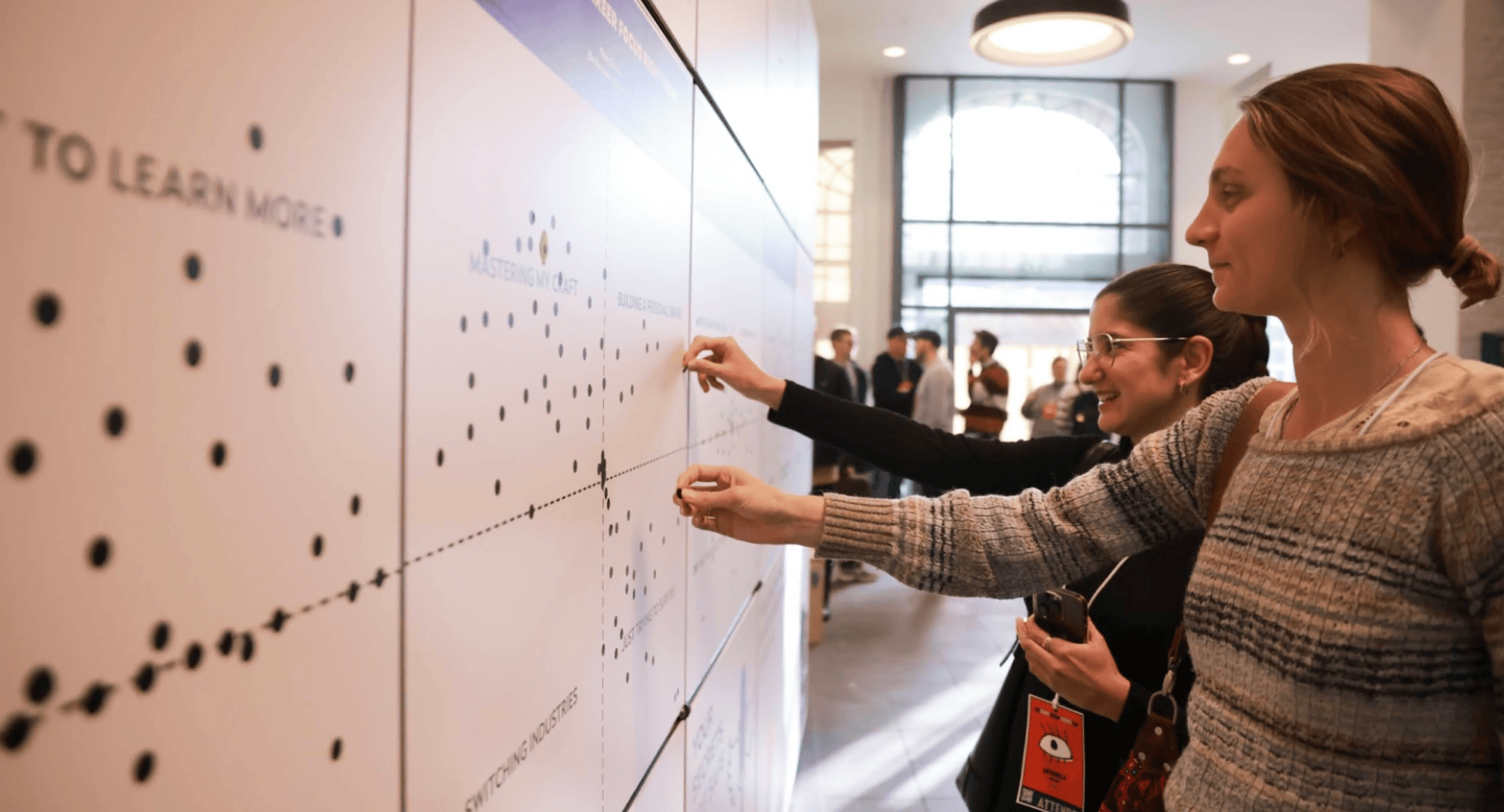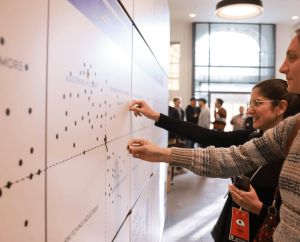Let’s be honest: When was the last time you filled out a questionnaire? Yeah, I thought so. We’ve all been there, staring at those endless rows of checkboxes, wondering if anyone actually reads our responses. But what if I told you there’s a way to make data collection not just bearable, but downright exciting?
As a data artist and founder of the data visualization studio NECESSITY.INK, I’ve always been fascinated by the intersection of art, design, and technology. The Design Confessional, our recent installation for the 10th edition of Design Matters, shows this intersection, transforming data collection into an engaging, interactive experience.
The Questionnaire Dilemma
Gathering data is crucial for organizations to understand their audience, make informed decisions, and measure their effectiveness. However, the process of collecting this information can be challenging, particularly for organizations with limited resources. It often requires significant time and financial investment, which can strain already stretched budgets and staff.
The project began with an intriguing challenge: create an installation that would engage conference attendees and invite them to actively shape the experience. This presented an opportunity to reimagine the traditional approach to audience surveys and data collection.

Active Participation: The Key Differentiator
Imagine this: You’re standing in a packed conference hall, surrounded by the hum of excited voices of the attendees. As you scan the room, your eyes are drawn to a massive, blank canvas stretching across one wall. As you approach, you notice small groups of people gathered around it, and they seem to have fun! They smile, chat, get inspired and make new connections.
This was the scene I envisioned when designing The Design Confessional. Instead of boring questionnaires, I designed an interactive installation that merged art, design, and real-time audience input. And it works without wi-fi or electricity! Attendees became active participants, answering questions and placing colorful stickers on the wall. Yes, stickers! With each interaction, the empty canvas slowly transformed into a vibrant, ever-evolving landscape of data.
As the day progressed, you could feel the energy in the room shift. People weren’t just passing by; they were stopping, discussing, and eagerly contributing their own pieces to the growing artwork. It was as if the wall had become a living, breathing entity, telling the collective story of everyone in the room. This wasn’t just data collection – it was a shared experience, a visual conversation that brought the Design Matters to life in ways we never imagined possible.

The Installation’s Reach and Impact
Data plays a crucial role in helping us make informed decisions and offer cultural experiences to a diverse audience. However, achieving true inclusivity presents significant challenges, as accommodating one group’s needs may exclude another. For instance, while in-person surveys might be more effective, digital alternatives could exclude people less familiar with technology.
What set this installation apart was its emphasis on active participation. Every interaction – from question choices to sticker placement – altered the artwork, making each person an integral part of the installation. This approach not only made data collection more engaging but also fostered a deeper connection with the content.
We blended data storytelling with low-fi, sustainable materials. This combination of digital visualization and tangible interaction transformed abstract information into a tactile, emotional experience. It demonstrated that high-tech concepts can be realized through accessible, sustainable means – a crucial consideration for designers working with limited resources.
The installation’s impact was significant: over 1,000 attendees, both in-person and via live stream, engaged with the artwork over the three-day event. More importantly, it catalyzed meaningful discussions about the intersection of design and technology, showcasing how interactive experiences like this can deepen audience connections in real-time. And we learned more about ourselves, right? The data we collected revealed some fascinating insights about our attendees. For example, 40% of participants expressed cautious optimism about AI, highlighting a balanced perspective on this rapidly evolving technology.
In terms of motivation, a significant 61% of attendees came with the primary goal of learning. This demonstrates a strong desire for professional growth and staying updated in the field. Interestingly, only 4% were looking to change careers.
When it comes to design trends, 32% believe they are overrated. Half of the attendees are concentrating on mastering their craft, showing a commitment to excellence and continuous improvement in their respective areas of expertise.
Lastly, I found some amusing insights about attendee motivations. While 19% admitted to coming for the free tote bag (who doesn’t love a good conference freebie?), a more substantial 56% were seeking fresh, practical ideas. This tells us that while swag is nice, the majority of our audience is truly invested in gaining actionable knowledge and inspiration to apply in their work.

One More Thing…
I’ve summarized my key takeaways for creative professionals.
- Rethink data collection: Traditional surveys can be time-consuming, expensive, and potentially intrusive. Consider innovative ways to gather information that engages and respects your audience.
- Personalize data: By allowing participants to see their input directly affecting the artwork, we made data feel personal and relevant.
- Balance technology and humanity: While data is crucial for decision-making, it’s important to maintain equilibrium between quantitative information and personal narratives.
- Embrace inclusivity challenges: Recognize that different approaches may be needed to reach diverse audiences, as one solution may not fit all.
The Design Confessional demonstrates that with creativity and innovative thinking, we can transform even the most routine aspects of our work into engaging, meaningful experiences. It challenges us to look beyond conventional methods and find new ways to connect with our audience, collect data, and create impactful designs.
At NECESSITY.INK, as we continue to push the boundaries of data visualization and audience engagement. Projects like The Design Confessional remind us of the power of interactive, participatory experiences. They show us that data collection doesn’t have to be a chore – it can be an art form in itself, one that engages, inspires, and connects.
***
Website: https://necessity.ink/
LinkedIn: https://www.linkedin.com/in/tizianaa/
X: https://twitter.com/Altiziana
Instagram: https://www.instagram.com/tiz.alocci/




